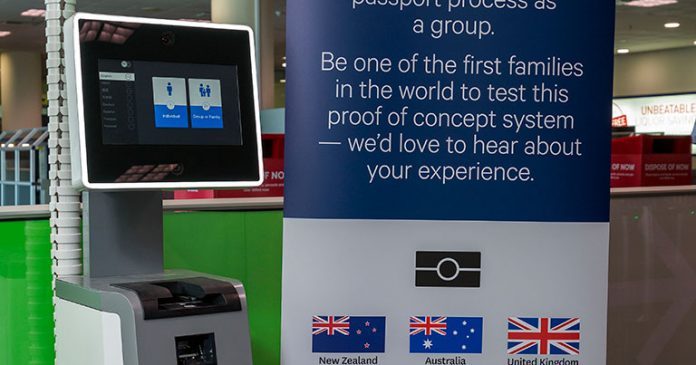Recently, passengers on some KLM flights departing Amsterdam haven’t shown a boarding pass to get on a plane. They haven’t needed to show their IDs, nor have they interacted with an agent at the boarding door.
By the time each passenger boards at the airline’s test gate, KLM’s systems already have scanned the traveler’s passport, boarding pass, and face. From there, passengers get on the plane — no documents required. Then, after the flight, the airline erases the data.
It’s just a test, and it may not speed the airport experience, since passengers still must wait in other lines. But KLM’s approach, along with similar ones from other airlines, including British Airways at London Heathrow and Air New Zealand in Brisbane, Australia, shows what’s possible with biometrics, and how future travelers may avoid showing documents at each stop in the terminal. Airlines expect they may soon scan passenger eyes, faces or fingerprints to authenticate each traveler.
Øverst på formularen
Nederst på formularen
This is not new technology. In many countries, including the United States, immigration officers use biometrics to confirm passenger identities. U.S. authorities generally use fingerprints, but elsewhere some governments have invested in less intrusive technology, such as iris scans and facial recognition. Some countries use biometrics at security checkpoints for identity checks.
Biometrics is still probably most useful for immigration and security services focused on securing airports and borders. But with the technology already being installed at many airports for other uses, airlines are beginning to test how they can use it to improve the passenger experience. For them, using biometrics can be trickier, since, unlike governments, who may require participation, airlines worry whether passengers will volunteer to share biometric data. Carriers may fear passengers will find iris or face scans creepy.
But insiders say airlines may soon embrace biometrics to make the passenger journey more efficient. And they say some big airlines might make large investments in the near future.
“It is just going to be one or two airlines that take the lead and end up driving the urgency,” said Michael S. Stromer, vice president for tech products at JetBlue Airways. “If it becomes something customers really like and one or two airlines are behind it, other airlines are going to get on board.”
For some travelers, biometrics is a scary word. Passengers may not want corporations having access to data that can be used to identify them. They might not want to acquiescence to facial or iris scans. They may not want to give their fingerprints.
But many consumers already are happily using biometrics, perhaps without even thinking about it. The most common use? It’s probably the iPhone, with its built-in fingerprint scanner that permits customers to unlock content by touching a button. Logging in is so convenient many customers hardly mind Apple is storing their fingerprints.
“Consumers have become so much more comfortable with biometrics,” said Joey Pritikin, vice president for sales and marketing at Tascent, a company that helps airports, airlines and security services install biometric technology.
Its biometric screen technologies are being used at Dubai International Airport and London Gatwick for security and border control-related purposes, and it recently developed a new iris and face scanning program that it says is much better than an older-generation system. The new platform, called Tascent InSight One captures iris and face images in about two seconds, as long as the person is 20 to 40 inches from the machine. The new system is also considerably smaller than Tascent’s old one, making it easier to introduce at airports.
Most of Tascent’s customers are still governments. But, recently, Pritikin said airlines have been evaluating how they can use the same technology to make passengers happier.
“What we are seeing is that airlines and airports are starting to leverage these same technologies and are looking at end-to-end biometric travel — ticketless, self service and automated,” he said.
JetBlue will test biometrics later this year at one airport — Stromer declined to share details — but the airline is generally waiting to see if an international standard develops among security and immigration services. It would be much easier, he and others said, if airlines could use the same technology government entities implement.
“I think the thing that has been slowing it down is airlines know that it’s a big capital investment,” Stromer said. “Everybody wants to get a feel for what works but everybody is hoping that as we continue to meet with these bodies, a standard will be created and we can get our arms around it.”
For now, the industry is generally focused on biometrics for the basics of travel — check-in, security screening, passport control, lounge access and boarding — but eventually JetBlue’s Stromer said technology might help personalize interactions.
Perhaps, he said, an agent might recognize a customer by name once the passenger approached a help desk. That way, the passenger would not have to give the agent a record locator before beginning the conversation. Most airline phone systems already have similar functionality, because they use a passenger’s phone number to automatically pull up the record.
Farther in the future, Stromer said facial recognition could be used to determine a passenger’s mood, since systems generally can tell whether someone is happy or sad.
“If you can tell the mood of the customer based on their face you might be able to personalize the experience for them,” he said. “Could you surprise and delight them? I think it’s a little bit of a stretch but I think there are some cool things that could come out of biometrics.”


























